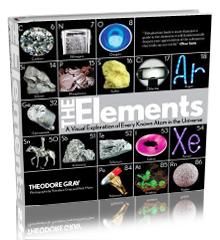Intramedullary nails. | |||
| Sample Image | |||
| Intramedullary nails. Paul Wellin's brother is an orthopedic surgeon. I know this because I was talking to Paul about how I hoped some day to meet an orthopedic surgeon who would have some left over body parts made out of titanium or tantalum that he could donate to my periodic table, upon which Paul said.... These bone pins were defective in some way, though they look rather pretty to me. They are over twelve inches long. Think about someone cutting open your body, drilling out the marrow of your bones and the ramming one of these things the whole length through, so they can screw some fittings on either end. Ouch. But at least you'll have some very attractive titanium in you from then on. Paul Wellin's Brother sent the following information about these samples: "Titanium has become a preferred material for Orthopedic implants over the past 10-15 years because of a number of its inherent properties. It is inert in the body, and has sufficient strength to support the mechanical loads (assuming proper design and size of the implant). It is also very resistant to fatigue failure - that is, it can undergo many (millions) of cycles of mechanical loading without failure - a property that is extremely important in an Orthopedic implant that will be subjected to a million cycles of loading a year. Most Orthopedic titanium implants are actually an alloy of titanium with small amounts of aluminum and vanadium, as pure titanium implants are somewhat brittle and have a higher rate of fracture. Titanium alloy is less brittle, and holds up quite well."Two and a half years later, Mike Lauter did this description one better by sending actual photographs of a bone pin very much like mine being pounded into his own actual leg: Ouch. That's all I can say, ouch. Source: Paul Wellin Contributor: Paul Wellin Acquired: 14 June, 2002 Text Updated: 16 March, 2009 Price: Donated Size: 12" Purity: >90% Sample Group: Medical | |||
|

